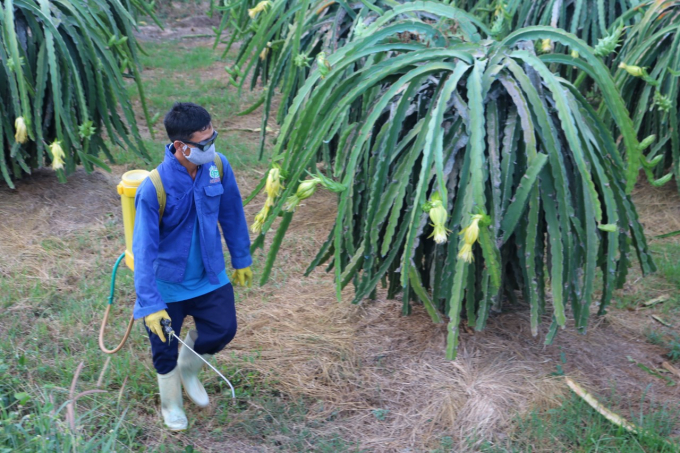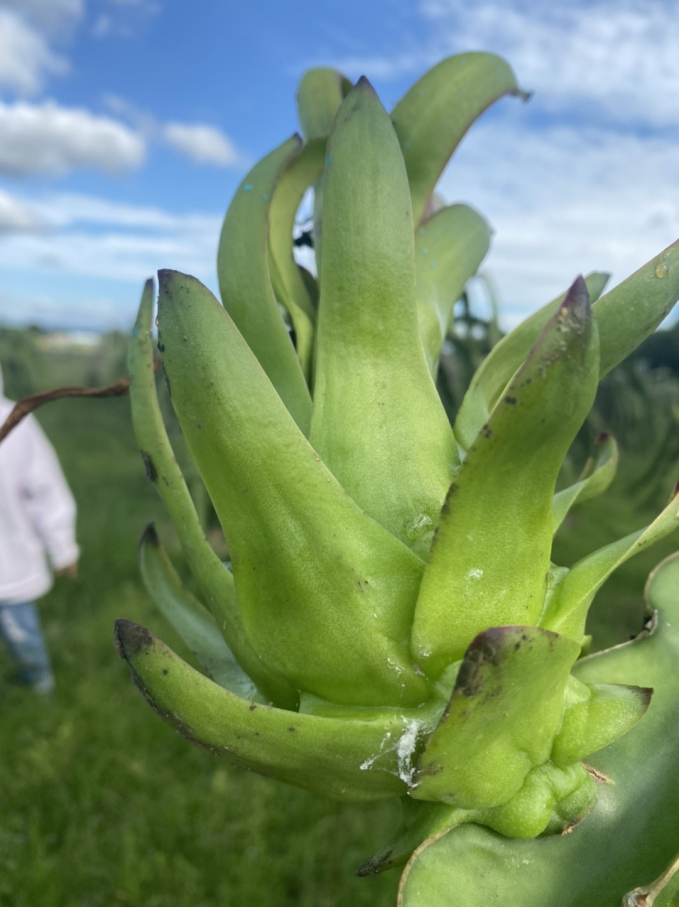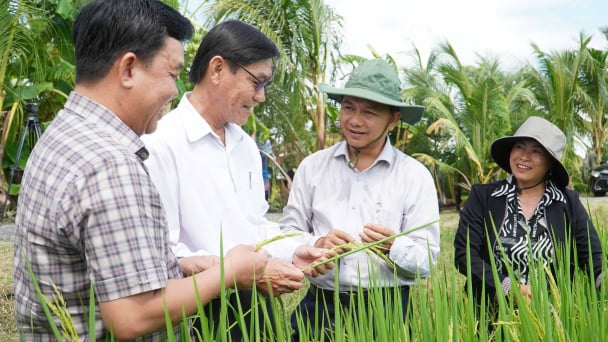June 21, 2025 | 01:06 GMT +7
June 21, 2025 | 01:06 GMT +7
Hotline: 0913.378.918
June 21, 2025 | 01:06 GMT +7
Hotline: 0913.378.918
Mealybugs still causing persistent damage to dragon fruits
Binh Thuan is the dragon fruit capital of the country with an area of up to 33,750 hectares, mainly concentrated in the districts of Southern Ham Thuan, Northern Ham Thuan and Bac Binh, with an average output of about 650,000 tons of fruit/year.

Recently, mealybugs appear in some dragon fruit growing areas in Binh Thuan. Photo: KS.
Mr. Do Van Bao, Director of Binh Thuan Plantation and Plant Protection Sub-Department, said that the mealybugs Dysmicoccus neobrevipes, Pseudococcus jackbeardsleyi are subjects under China's plant quarantine, requiring establishments to strictly inspect and monitor the processing and packaging of dragon fruits. Therefore, before packaging dragon fruits, it is necessary to exterminate these bugs.
Under the direction by the Ministry of Agriculture and Rural Development, since 2019, Binh Thuan Department of Agriculture and Rural Development has directed the Sub-department of Plantation and Plant Protection to set up a team to inspect, detect and guide dragon fruit exporters and farmers to prevent, treat mealybugs before exporting.
As a result, the team discovered a number of dragon fruit export establishments in the area affected by mealybugs. But they were unnoticed, so the team sent a document to identify mealybugs and how to remove them by washing or blowing. Subsequently, businesses and farmers have been proactive in eliminating and preventing mealy bugs on dragon fruit trees.
Recently, mealybugs appear on dragon fruit trees in the province. Mai Thi Thuy Kieu, Head of Domestic Plant Quarantine Station (Sub-Department of Plantation and Plant Protection), said that in early August 2021, there were about 89 hectares of dragon fruit in Bac Binh and Southern Ham Thuan damaged by mealybugs. Prevention solutions have been specifically guided by the Sub-Department to farmers.
Experience in handling mealybugs
According to Ms. Kieu, the standard way to identify mealybugs is that they have an oval body, slightly rounded on the back, light orange to pink in color, body covered with thin wax, no vertical lines on the back and carry an egg bag on the side.

It is necessary to regularly check, identify and prevent early dragon fruit mealybugs. Photo: KS.
Around the body there are 17 pairs of waxy tassels, the length of these tassels increases posteriorly, the front pair is 1/4 of the length of the body, the rear pair is 1/4 to 1 times the length of the body, straight, except for the rear pair which is usually curved upwards.
All parts of the dragon fruit tree such as flowers, stems and fruit can be attacked by mealybugs. Bugs use stingers to puncture the epidermis of stems, branches, and fruits... to absorb nutrients. The stings make the damaged tissue dark brown, the outer symptoms of the fruit skin are yellow in color. The bugs thrive in hot and humid weather, and damage is common during the dry season.
According to Ms. Kieu, to effectively prevent mealybugs, farmers must regularly clean, collect and destroy remnants around the dragon fruit tree, cut off diseased branches, clear grass, and help with ventilation for the garden, creating favorable conditions for plants to grow and develop, limiting the habitat of mealybugs.
In addition, adequate watering and fertilizing is needed to limit the growth of mealybugs. In the process of watering dragon fruit, it is recommended to use a water pump to have a strong spray on places and wash where many mealybugs are attached, create moisture on the tree and reduce the density of mealybugs.
“People must regularly check their gardens to identify harmful bugs early, especially in the dry season. Pay attention to parts such as young shoots, flowers, and fruits that bugs often latch onto. From there, prune and destroy the parts of the plant that are heavily infected with mealybugs,” noted Ms. Kieu.

A dragon fruit affected by mealybugs at its young stage. Photo: KS.
Additionally, it is necessary to protect the natural enemies of mealybugs in the garden such as weaver ants, ladybugs, yellow-eyed beetles, tendon beetles, red bugs, and parasitic wasps. In particular, weaver ants are the most effective natural enemies, they eat larvae, adult mealybugs and can repel and prevent adult bugs from harming and laying eggs. Farmers need to use parasitic fungi preparations Mertahizum anisopliae, Beauveria bassiana or Paecilomyces sp. Spray to eliminate mealybugs, dosage according to the packaging recommendations.
It should also be noted spraying insecticides works best at the stage when the tree is flowering, bearing young fruits, and developing fruits. But farmers should use pesticides according to the "4 right" principle and ensure the isolation period.
The drugs must be on the list of permitted use issued by the Ministry of Agriculture and Rural Development every year to control mealybugs when there is a risk of harm, seriously affecting yield and quality. Mealybugs have a waxy coating on the outside, so it is necessary to add an adhesive to the drug solution to increase adhesion.
According to Binh Thuan Plantation and Plant Protection Sub-Department, if the Covid-19 pandemic situation in the area is controlled, the Sub-Department will continue to set up a team to guide dragon fruit exporters on measures to handle mealybugs before packing for export.
In addition, the Sub-department is currently collaborating with the Institute of Plant Protection to carry out trials on the control of this bug on dragon fruit, from farming methods to the use of chemical and biological products.
Translated by Nguyen Hai Long
/2025/06/17/3942-2-143243_548.jpg)
(VAN) Recently, in Sweden, the Secretary of the Binh Dinh Provincial Party Committee presented the Investment Registration Certificate for the 'Polyester Fabric Recycling Complex' project to SYRE Impact-AB Company.
/2025/06/12/3721-2-202745_83.jpg)
(VAN) TH made an impression at Seoul Food 2025 with its line of natural beverages, paving the way for Vietnamese food products to enter the South Korean market.

(VAN) Soc Trang's success in rice exports stems from a strategy of developing fragrant and specialty rice cultivation areas and standardizing production toward low-emission practices.
/2025/06/11/1311-5-120811_839.jpg)
(VAN) The pig farming industry is facing the challenge of comprehensive restructuring to meet requirements for quality, safety, traceability, and market expansion both domestically and for export.

(VAN) Vietnam considers participating in ALGROALBA in order to expand agricultural production, coordinate the assessment and effective exploitation potential land.
/2025/06/05/5314-1-184727_407.jpg)
(VAN) From seemingly worthless fish scales and skin, enzymes and lactic ferments can transform by-products into peptides, opening a sustainable, effective business direction and elevating Vietnamese seafood.

(VAN) TTC AgriS and IFC signed a strategic partnership to develop a sustainable agricultural value chain, aiming to achieve the Net Zero target by 2035.